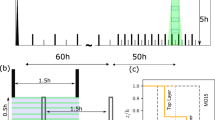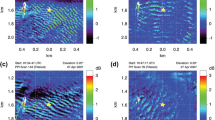Abstract
Measurements of turbulence structure in a wind-tunnel model canopy of bluff elements show many of the features associated with vegetation canopies and roughness sublayers but also display features more characteristic of the inertial sublayer (ISL). Points of similarity include the existence of an inflexion point in the space-time averaged streamwise velocity at the canopy top, the variation with height of turbulent second moments and the departure of the turbulent kinetic energy budget from local equilibrium in and just above the canopy. Quadrant analysis shows characteristic dominance of sweep over ejection events within the canopy although sweeps are more frequent than usually seen in vegetation canopies. Points of difference are a u′, w′ correlation coefficient that is closer to the ISL value than to most canopy data, and a turbulent Prandtl number midway between canopy and ISL values. Within the canopy there is distinct spatial partitioning into two flow regimes, the wake and non-wake regions. Both time-mean and conditional statistics take different values in these different regions of the canopy flow. We explain many of these features by appealing to a modified version of the mixing-layer hypothesis that links the dominant turbulent eddies to the instability of the inflexion point at canopy top. However, it is evident that these eddies are perturbed by the quasi-coherent wakes of the bluff canopy elements. Based upon an equation for the instantaneous velocity perturbation, we propose a criterion for deciding when the eddies linked to the inflexion point will dominate flow structure and when that structure will be replaced by an array of superimposed element wakes. In particular, we show that the resemblance of some features of the flow to the ISL does not mean that ISL dynamics operate within bluff-body canopies in any sense.
Similar content being viewed by others
References
Baldocchi DD, Hutchison BA (1987) Turbulence in an almond orchard: vertical variations in turbulent statistics. Boundary-Layer Meteorol 40: 127–146
Böhm M (2000) The role of source distribution on scalar transfer within and above plant canopies. PhD Thesis, Australian National University, Canberra, 318 pp
Brunet Y, Finnigan JJ, Raupach MR (1994) A wind-tunnel study of air flow in waving wheat: single-point velocity statistics. Boundary-Layer Meteorol 70: 95–132
Castro IP, Cheng H, Reynolds R (2006) Turbulence over urban-type roughness: deductions from wind-tunnel measurements. Boundary-Layer Meteorol 118: 109–131
Christen A, Vogt R (2004) Direct measurement of dispersive fluxes within a cork oak plantation. In: Proceedings of 26th conference on agricultural and forest meteorology. American Meteorological Society, Vancouver
Coceal O, Thomas TG, Castro IP, Belcher SE (2006) Mean flow and turbulence statistics over groups of urban-like cubical obstacles. Boundary-Layer Meteorol 121: 491–519
Drazin PG, Reid WH (1981) Hydrodynamic stability. Cambridge University Press, UK, 527 pp
Finnigan JJ (1979) Turbulence in waving wheat. II. Structure of momentum transfer. Boundary-Layer Meteorol 16: 213–236
Finnigan JJ (2000) Turbulence in plant canopies. Annu Rev Fluid Mech 32: 519–571
Finnigan JJ, Shaw RH (2008) Double-averaging methodology and its application to turbulent flow in and above vegetation canopies. Acta Geophys 56(3): 534–561
Finnigan JJ, Shaw RH, Patton EG (2009) Turbulence structure above a vegetation canopy. J Fluid Mech 637: 387–424
Gardiner BA (1994) Wind and wind forces in a plantation spruce forest. Boundary-Layer Meteorol 67: 161–186
Harman IN, Finnigan JJ (2007) A simple unified theory for flow in the canopy and roughness sublayer. Boundary-Layer Meteorol 123: 339–363
Harman IN, Finnigan JJ (2008) Scalar concentration profiles in the canopy and roughness sublayer. Boundary-Layer Meteorol 129: 323–351
Hughes DE, Böhm M (2000) Hitchhikers guide to the Pye Laboratory Wind-tunnel. Technical report. CSIRO Land and Water, Canberra, 101 pp
Hunt JCR, Carruthers DJ (1990) Rapid distortion theory and the ’problems’ of turbulence. J Fluid Mech 212: 497–532
Hunt JCR, Abell CJ, Peterka JA, Woo H (1975) Kinematical studies of the flows around free or surface-mounted obstacles; applying topology to flow visualisation. J Fluid Mech 86(1):179–200
Jackson PS (1981) On the displacement height in the logarithmic velocity profile. J Fluid Mech 111: 15–25
Judd MJ, Raupach MR, Finnigan JJ (1996) A wind-tunnel study of turbulent flow around single and multiple windbreaks. Part I. Velocity fields. Boundary-Layer Meteorol 80: 127–165
Kaimal JC, Finnigan JJ (1994) Atmospheric boundary-layer flows. Oxford University Press, New York, 289 pp
Katul GG, Poggi D, Cava D, Finnigan JJ (2006) The relative importance of ejections and sweeps to momentum transfer in the atmospheric boundary-layer. Boundary-Layer Meteorol 120: 367–375
Legg BJ, Coppin PA, Raupach MR (1984) A three-hot-wire anemometer for measuring two velocity components in high intensity turbulent boundary-layers. J Phys E 17: 970–976
Lu SS, Willmarth WW (1973) Measurements of the structure of Reynolds stress in a turbulent boundary-layer. J Fluid Mech 60: 481–571
Marshall BJ, Wood CJ, Gardiner BA, Belcher SE (2002) Conditional sampling of forest canopy gusts. Boundary-Layer Meteorol 102: 225–251
Meyers TP, Baldocchi DD (1991) The budget of turbulent kinetic energy and Reynolds stress within and above a deciduous forest. Agric For Meteorol 53: 207–222
Mulhearn PJ, Finnigan JJ (1978) Turbulent flow over a very rough, random surface. Boundary-Layer Meteorol 15: 109–132
Poggi D, Katul GG (2008) The effect of canopy roughness density on the constitutive components of the dispersive stresses. Exp Fluids 45: 111–121
Poggi D, Katul GG, Albertson JD (2004a) A note on the contribution of dispersive fluxes to momentum transfer within canopies. Boundary-Layer Meteorol 111: 615–621
Poggi D, Porporato A, Ridolfi L, Albertson JD, Katul GG (2004b) The effect of vegetation density on canopy sub-layer turbulence. Boundary-Layer Meteorol 111: 565–587
Raupach MR (1992) Drag and drag partition on rough surfaces. Boundary-Layer Meteorol 60: 375–395
Raupach MR (1994) Simplified expressions for vegetation roughness length and zero-plane displacement as functions of canopy height and area index. Boundary-Layer Meteorol 71: 211–216
Raupach MR, Legg BJ (1983) Turbulent dispersion from an elevated line source: measurements of wind- concentration moments and budgets. J Fluid Mech 136: 111–137
Raupach MR, Shaw RH (1982) Averaging procedures for flow within vegetation canopies. Boundary-Layer Meteorol 22: 79–90
Raupach MR, Coppin PA, Legg BJ (1986) Experiments on scalar dispersion within a model plant canopy. Part I: The turbulence structure. Boundary-Layer Meteorol 35: 21–52
Raupach MR, Antonia RA, Rajagopalan S (1991) Rough-wall turbulent boundary-layers. Appl Mech Rev 44(1): 1–25
Raupach MR, Finnigan JJ, Brunet Y (1996) Coherent eddies and turbulence in vegetation canopies: the mixing-layer analogy. Boundary-Layer Meteorol 78: 351–382
Roth M (2000) Review of atmospheric turbulence over cities. Q J R Meteorol Soc 126: 941–990
Rouse H (ed) (1959) Advanced mechanics of fluids. Wiley, New York, 444 pp
Schlichting H (1968) Boundary-layer theory. McGraw-Hill, New York, 747 pp
Shaw RH, Seginer I (1987) Calculation of velocity skewness in real and artificial plant canopies. Boundary-Layer Meteorol 39: 315–332
Shaw RH, Tavangar JT, Ward DP (1983) Structure of the Reynolds Stress in a canopy layer. J Clim Appl Meteorol 22: 1922–1931
Shaw RH, Brunet Y, Finnigan JJ, Raupach MR (1995) A wind-tunnel study of air flow in waving wheat: two-point velocity statistics. Boundary-Layer Meteorol 76: 349–376
Su H-B, Shaw RH, Paw U KT, Moeng C-H, Sullivan PP (1998) Turbulent statistics of neutrally stratified flow within and above a sparse forest from large-eddy simulation and field observations. Boundary-Layer Meteorol 88: 363–397
Tennekes H, Lumley JL (1994) A first course in turbulence. The MIT Press, Cambridge, 300 pp
Thom AS (1971) Momentum absorption by vegetation. Q J R Meteorol Soc 97: 414–428
Townsend AA (1976) The structure of turbulent shear flow. Cambridge University Press, UK, 429 pp
Wooding RA (1968) A low-speed wind-tunnel for model studies in micrometeorology. I. The Pye Laboratory Wind-tunnel technical paper, 25. Australian CSIRO Division of Plant Industry, 39 pp
Author information
Authors and Affiliations
Corresponding author
Rights and permissions
About this article
Cite this article
Böhm, M., Finnigan, J.J., Raupach, M.R. et al. Turbulence Structure Within and Above a Canopy of Bluff Elements. Boundary-Layer Meteorol 146, 393–419 (2013). https://doi.org/10.1007/s10546-012-9770-1
Received:
Accepted:
Published:
Issue Date:
DOI: https://doi.org/10.1007/s10546-012-9770-1




